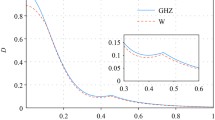Abstract
We study entanglement dynamics of qubit–qutrit pair under Dzyaloshinskii–Moriya (DM) interaction. The qubit–qutrit pair acts as a closed system and one external qubit serve as the environment for the pair. The external qubit interact with qubit of closed system via DM interaction. This interaction frequently kills the entanglement between qubit–qutrit pair, which is also periodically recovered. On the other hand two parameter class of state of qubit–qutrit pair also affected by DM interaction and one parameter class of state remains unaffected. The frequency of occurrence of entanglement sudden death and entanglement sudden birth in two parameter class of state is half than qubit–qutrit pure state. We used our quantification of entanglement as negativity measure.







Similar content being viewed by others
References
Einstein, A., Podolsky, B., Rosen, N.: Can quantum-mechanical description of physical reality be considered complete? Phys. Rev. 47, 777–780 (1935)
Bennett, C.H., Brassard, G., Crépeau, C., Jozsa, R., Peres, A., Wootters, W.K.: Teleporting an unknown quantum state via dual classical and Einstein–Podolsky–Rosen channels. Phys. Rev. Lett. 70, 1895–1899 (1993)
Nielsen, M.A., Chuang, I.L.: Quantum Computation and Quantum Information. Cambridge University Press, Cambridge (2000)
Ekert, A.K.: Quantum cryptography based on Bells theorem. Phys. Rev. Lett. 67, 661–663 (1991)
Panigrahi, P.K., Mitra, C.: Use of quantum correlation: a theoretical and experimental perspective. J. Indian Inst. Sci. 89, 333–350 (2009)
Yu, T., Eberly, J.H.: Finite-time disentanglement via spontaneous emission. Phys. Rev. Lett. 93, 140404 (2004)
Yu, T., Eberly, J.H.: Sudden death of entanglement. Science 30, 598–601 (2009)
Ann, K., Jaeger, G.: Entanglement sudden death in qubit-qutrit systems. Phys. Lett. A 372, 579–583 (2008)
Karpat, G., Gedik, Z.: Correlation dynamics of qubit–qutrit systems in a classical dephasing environment. Phys. Lett. A 375, 4166–4171 (2011)
Hai-Rui, W.: Dynamics of entanglement for a two-parameter class of states in a qubit–qutrit system. Commun. Theor. Phys. 57, 983–990 (2012)
Albanese, C.: On the spectrum of the Heisenberg Hamiltonian. J. Stat. Phys. 55, 297–309 (1989)
Ising, Ernst: Beitrag zur theorie des ferromagnetismus. Z. Phys. 31, 253–258 (1925)
Jaynes, E.T., Cummings, F.W.: Comparison of quantum and semiclassical radiation theories with application to the beam maser. Proc. IEEE 51, 89–109 (1963)
Dzyaloshinsky, I.: A thermodynamic theory of “weak” ferromagnetism of antiferromagnetics. J. Phys. Chem. Solids 4, 241–255 (1958)
Moriya, T.: New mechanism of anisotropic superexachange interaction. Phys. Rev. Lett. 4, 228–230 (1960)
Moriya, T.: Anisotropic superexchange interaction and weak ferromagnetism. Phys. Rev. Lett. 120, 91 (1960)
Affleek, I., Haldane, F.D.M.: Critical theory of quantum spin chains. Phys. Rev. B 36, 5291–5300 (1987)
Vidal, G., Werner, R.F.: Computable measure of entanglement. Phys. Rev. A 65, 032314 (2002)
Plenio, M.B., Virmani, S.: An introduction to entanglement measures. Quantum. Inf. Comp. 7, 1–51 (2007)
Peres, A.: Quantum Theory: Concepts and Methods. Kluwer, Dordrecht (1995)
Peres, A.: Higher order Schmidt decompositions. Phys. Lett. A 202, 16–17 (1995)
Schmidt, E.: Zur theorie der linearen und nichtlinearen Integralgleichungen. I. Teil: Entwicklung willkrlicher funktionen nach systemen vorgeschriebener. Math. Ann. 63, 433–476 (1907)
Ekert, A., Knight, P.L.: Entangled quantum systems and the Schmidt decomposition. Am. J. Phys. 63, 415 (1995)
Pyo Chi, D., Lee, S.: Entanglement for a two-parameter class of states in \(2\otimes n\) quantum system. J. Phys. A: Math. Gen. 36, 11503–11510 (2003)
Author information
Authors and Affiliations
Corresponding author
Rights and permissions
About this article
Cite this article
Sharma, K.K., Awasthi, S.K. & Pandey, S.N. Entanglement sudden death and birth in qubit–qutrit systems under Dzyaloshinskii–Moriya interaction. Quantum Inf Process 12, 3437–3447 (2013). https://doi.org/10.1007/s11128-013-0607-8
Received:
Accepted:
Published:
Issue Date:
DOI: https://doi.org/10.1007/s11128-013-0607-8




